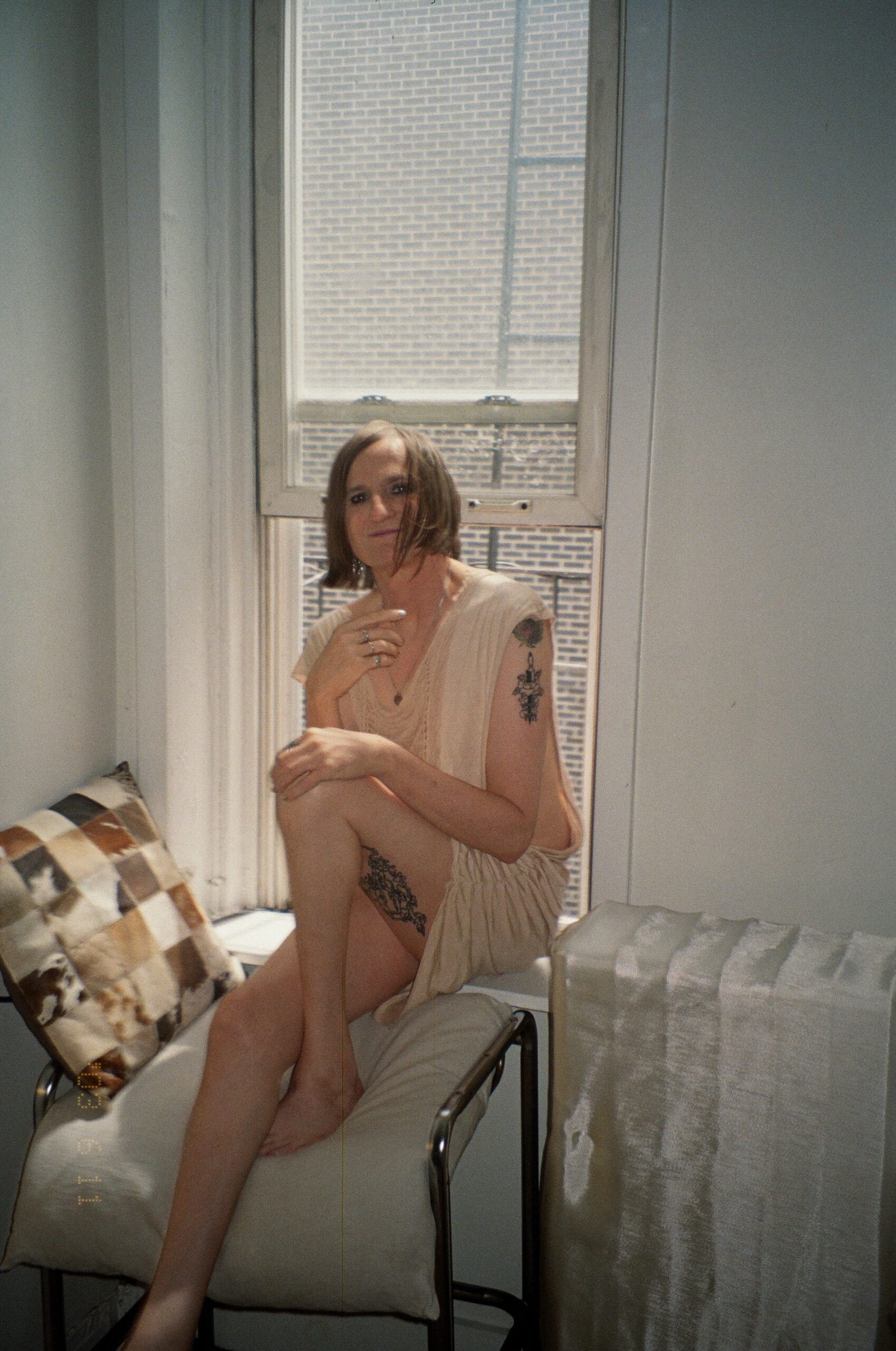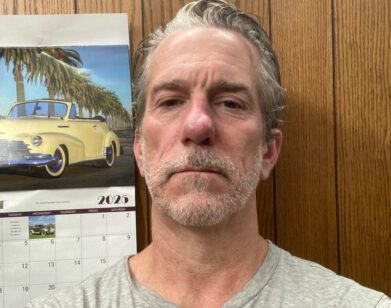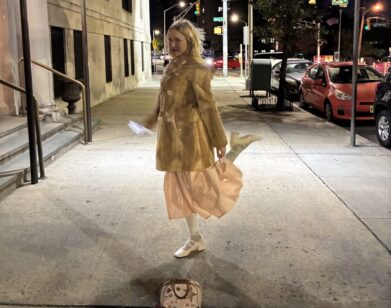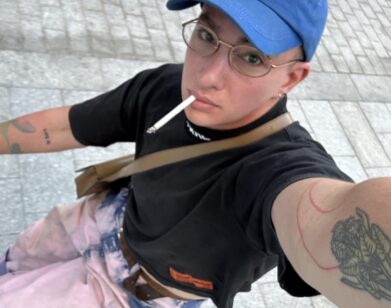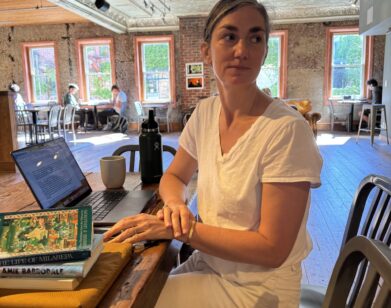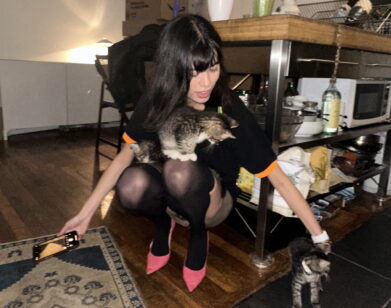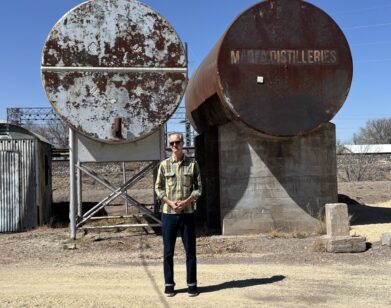RAVE
McKenzie Wark on Raving and the “Gentrification of Ketamine”
The first time I spotted McKenzie Wark at a party, she was writhing by the DJ booth at Brooklyn’s Bossa Nova Civic Club, cutting a striking figure amongst a gaggle of Zoomers. So many feel self-conscious about aging in a scene that romanticizes youth, but not the 61-year-old Wark, who blooms on the dance floor as she grooves with the sweaty, eyes-closed gusto of someone who truly believes.
The New School professor turned diehard raver is a star of a growing milieu of writers attempting to catalog contemporary rave culture and capture its ephemeral essence. Drawing from her exploits in Brooklyn’s queer underground nightlife scene during the late-2010s and 2020s, Wark’s new book Raving is out this week from Duke University Press. The bite-sized text approximates an etiquette guide on the practice of partying, and is buoyed by the emotional intimacy of autofiction. Critical theory provides a conceptual framework—including Wark’s tongue-in-cheek taxonomy of the archetypes of people found at raves, from the “coworker” to the “punisher.” (You might already be familiar with the types). The book ultimately asks: who is raving for—who really needs it?
On a cold spring afternoon, I called her to compare our notes on the underground, discuss ketamine’s influence on New York dancefloors, and the deliciously horny energy that pulses like an electric undercurrent through Raving.
———
MICHELLE LHOOQ: Hey girl, what’s up?
MCKENZIE WARK: Everything’s fine at this end. How’re you doing?
LHOOQ: I’m doing really good. Where are you right now?
WARK: I’m in my girlfriend’s apartment in New Jersey.
LHOOQ: How was Spain? I know you were just there.
WARK: I had a really nice time. I mean, it’s kind of exhausting, but I do love attention. I did six events in three cities, plus Berlin.
LHOOQ: Did you get to go out at all?
WARK: Well, of course I went to Berghain.
LHOOQ: How was that?
WARK: It was good. There was just a whole bunch of fucking New Yorkers there. So it was kind of great, because I don’t take drugs through airports or anything, but apparently other people do.
LHOOQ: Yeah. I was on a plane to Croatia, earlier this year and I met some ravers on the plane who told me that they’d snuck ketamine up their vaginas, and they were doing it on the airplane, and asked me if I wanted to join.
WARK: Oh my god. I don’t think a K-hole would be a good way to do an international flight.
LHOOQ: Only if you can get past security. I think being in a K-hole in TSA would be horrible.
WARK: That’s the thing. Because it comes up pretty quick. So you’d have to get through security, and I’m just never going to do that.
LHOOQ: I’m so excited to chat with you about this book. I wanted to start with your journey as a raver, how you started raving in Australia in the nineties and basically ended up in Bushwick in the 2010s.
WARK: In the nineties, it was a combination of being around the periphery of this DIY scene that was happening. There were sort of hardcore synthesizer music people gathered around a lab called Clan Analogue. There was a sort of crunchy hippy wing of it that was called Vibe Tribe, who would do parties in the Bush Doof. And there was an outfit called the Non-Bossy Posse, which was the anarchist version of it. I was just someone who showed up to stuff. But that was sort of the matrix of the Sydney scene in the mid-nineties. And I had also been to Berlin and Amsterdam, which I didn’t really understand at the time. I got to go to these clubs in what was the newly incorporated part of East Berlin without really quite understanding the significance of it, I think. And I immigrated, for love, to New York. I married a New Yorker, who was more like a rock-and-roll chick, so we weren’t really going dancing to techno. But after I transitioned, I kind of went back to it, because my trans mom was a raver, and I was talking about how dancing always seemed to work for my body. There was a way that it worked on my dysphoria, and she was like, “Well, you’re coming dancing this weekend.” And that was my return to the New York scene, which I guess is 2018 or something.
LHOOQ: That’s super interesting. You say that in the nineties you didn’t quite get the significance of raving. What was raving to you back then?
WARK: I mean, we were all doing ecstasy in those days, and massive doses too, so there was this sort of plunging-into-blob-state side to it. And not that I have anything against that, but to me, that sort of misses certain sides. It’s like putting too much sugar in your coffee. A little taste can be good, but you don’t always need to put four heaped spoon falls in. So that was one thing I hadn’t quite got, but there’s a whole bunch of elements here. I sort of didn’t really understand techno as a Black music, because I first encountered it through white people in Sydney and Berlin. So I only later figured out the history of it. I didn’t mean to, but I made myself popular by saying, “Oh, I was at parties like this in the nineties, but this is better.” Everybody was like, “What?” Because there’s all of this sort of mythologizing about the past. But in some ways, I still think that’s true.
LHOOQ: I find your historical memory really interesting, and I’m wondering what you see as being similar between what’s happening now in Brooklyn and what you experienced back in the nineties, and why you think it’s better?
WARK: I wasn’t deep in it in the nineties, so I’m not claiming some great insider knowledge or anything. I like the idea of transforming a space and running it as long as you want, and there’s a through line around that. But the techniques that you do it with got a hell of a lot simpler and easier. The way you light it, not carting huge numbers of records around. DJs have so much more flexibility about how they program. And in some quarters at least, a little bit of learning how to filter interesting people into that space. You can find a little more sophistication around that.
LHOOQ: One thing that’s really interesting to me about your journey is how you went away and came back to it in your fifties and sixties.
WARK: The thing about transexuals is we sort of have two ages. It’s how long you’ve been going since birth, but how long since you came out. And I was doing this all through the early transition, second puberty, emotional madness era. So I was kind of a 19-year-old trapped in a seven-year-old body for a while. As a writer, I think it can be useful to just approach situations without trying to master them, to just try to experience them with a little bit of wonder. And the book’s meant to have that quality. I’m not claiming expertise, I’m just someone who’s in this world often enough that I can sort of see a pattern and a picture in it. I think sometimes that’s a good position to write from. If you are right in the middle of it, there’s things you don’t see anymore and take for granted. So to be familiar enough, but not overly familiar, was one of the things I was sort of aiming for while writing it.
LHOOQ: It’s so interesting that this is the first book you’ve written since starting hormones, and that it allowed you to break a curse of writer’s block. What do you think it was about writing about raving that helped you get unstuck?
WARK: Yeah. I mean, I was continually writing. I could write articles and things. To me, articles are easy, but books are hard, because they’re much more complex, organic sort of beasts. And I just couldn’t get anything to work at that sort of scale. And it was a bit like if I was a clarinet player and someone handed me a saxophone, like I sort of know how to play this. But hormones had that effect on my emotions and my body, and its effects are subtle. So I just wasn’t familiar with the instrument anymore. And I’m someone who’s prone to little experiences of mania. And I was asked if I could do this book in three months and in a moment of mania, I said, “Yeah.” So that was how it came about. And I had a commission from NOON Magazine, and sometimes commissions are generative in that sense. Sometimes articles grow into things. And the lower stakes of the article let me find the style, where there’ll be a description of a situation and some characters will pass through it, and we’ll try to extract a feeling and a concept out of what’s going on—on the dance floor, in the chill out, or getting through the door, whatever piece of the story or the situation.
LHOOQ: I’d love to talk a little more about style, actually. You have a lot of short sentences. There’s this sort of immediacy to the way you write about the rave where, it seems to me, you’re really trying to capture what the embodied experience is on the dance floor.
WARK: I’m not trying to represent the rave so much as let it seep into the form of expression. So a little bit of the rhythm of techno is in it, and the layering of techno. Jazz was, aesthetically, what I learned most from as a writer. But this one was listening to techno and thinking about the layers of sound on top of each other, and how they phase in and out, and what the rhythm is. So yeah, the writing was influenced a lot by that sound. Most of the book is in the present tense, that’s why it gives you that feeling that you’re coming with me as I navigate the dance floor. So it’s just that simple device. The solutions end up being really simple with writing.
LHOOQ: So your writing was sort of influenced by techno. Was it also influenced by ketamine?
WARK: Going to have to say yes. And mushrooms and ecstasy a little bit, but not so much. There aren’t elaborate descriptions of drug experiences, because it’s really hard to pull that off and people get bored with that. So it’s more about how ketamine makes you experience your body. Or, how does it make you focus on certain really crunchy details and sound? And that’s just in it. That’s just in the book without me saying, “Hey, I’m on ketamine, this is what it’s like.” And I won’t have to bother the reader too much with lengthy descriptions of trips, because who’s here for that?
LHOOQ: Well, it’s funny that you say it’s hard to capture the experience of being in a dissociated state because I feel the same way about writing on raving. I feel like you’re trying to capture something that’s inherently ephemeral, and that by trying to record it, you kind of change it. Right?
WARK: How can we express what we’ve collectively learned is one thing about it. There’s a set of practices and experiences and disasters. We’ve all been at a bad party. What have we learned? And how can writing not be extractive and exploitative? How can writing be something that’s like, “I want to write a book for people in this world, as well as for people who might want to construct situations of a different kind, who have that sort of desire? How can we be together? How can we do something?” It’s a collective experience. So I’m trying to find a way to write for people in the rave world, and then outside.
LHOOQ: In some ways, the book seemed to be an instruction or etiquette guide on how to rave.
WARK: A little bit. I don’t like the policing approach to these spaces, but it’s an art. It’s an art that you can get better at. And I kind of gravitate to people who practice it with a bit of skill. How you dance with other people, how you help someone who’s in trouble. There’s just ways of doing it that you can learn how to not be that asshole that everybody will bitch about later. And that’s one of the other reasons to not encourage tourism in it. Anybody who wants to find these worlds can find them. They’re not actually really exclusive, but there is a bit of a learning curve.
LHOOQ: You’ve mentioned a couple of times that writing about the underground is such a delicate practice, and you’re trying to both illuminate but also obfuscate things about it, which I think is super interesting. I’m wondering if you could talk about some of the tactics that you use to hide or protect certain pieces of information.
WARK: There’s the conceit of what I call the “rave continuum.” The sense that every really peak moment in a rave is in the same timeline as every other peak moment. And that little writerly conceit lets me segue from scenes that actually happened at different parties on different nights at different venues, as if they’re happening in the same place. So you won’t recognize any particular night, because I’ve sort of chopped it up and re-edited it. I don’t name venues, I don’t name parties. I do name DJs, because if a DJ does a good show, let’s honor that. But yeah, I’m not interested in doing free promotion by naming what these shows were. I’m a non-fiction writer. Certain things, I want to cue to my experience, but there’s certain details people don’t need to know.
LHOOQ: What I love about the book is this injection of critical theory. You kind of create this conceptual framework that feels like a new language that goes beyond a lot of the cliches that people usually use to write about raving. I’m wondering if you could maybe explain some of the terms that you’ve come up with to describe the culture of raving and altered states. What’s the difference between a raver, a coworker and a punisher?
WARK: One thing I did is create a cast of types. And one thing about city living is we tend to process the people around us as if they’re types. That can go horribly wrong when you stereotype people, right? But there’s a way in which you’re just going to do it in an urban space anyway, because you have to size up what someone is to you on the subway or on the street or on the dance floor. The first guy to punish you is the person who is just going to show no respect whatsoever for the fact that you are also there. So they’re going to get their fucking phone out and take a picture of you, they’re going to move around the space as if you’re not there. The punisher is just really preventing anybody around them from having a good time. The coworker is a slightly different animal. A coworker is someone who’s looking for the story they’re going to tell their coworkers on Monday. And I get it, there’s a need to treat this as leisure and release all that stress. But the coworker can also be hard to be around, because they just go at it too fucking hard. They’re too drunk and they’re doing that woo thing. But I think the raver is a little different. For the raver, it’s not bad. We’re there because we need this particular thing and we’re just going to grind on this beat for hours. And we’re trying to be aware of each other, to view it as a collective practice of dancing together. So yeah, I was trying to think a little bit through social types. And then there’s club kids, who see being seen as part of the experience. And that’s valid and it’s important, and that space should exist. But I prefer a rave that’s less about that experience. So it’s meant to be lighthearted, that all of these things are functions at nightlife, but asking one space to do them all is not going to work.
LHOOQ: What do you think ketamine’s dominance over the dance floor has done to rave culture? How has it changed the vibe, since the “blob state” that you were describing in the nineties?
WARK: Yeah, ketamine’s a whole other thing. And it can take some people out of the space of being present with others, but it can also bring you into a certain alignment with others and with music. And I think there’s a way in which it has anesthetic properties; obviously, there’s certain things you’re not sensing. It pairs well with certain kinds of music, some crystalline quality to focus on. So it doesn’t give you that one big blob of accelerated feeling good about others that the ecstasy dance floor had, or has. But it does maybe have that somewhat more spacey, dissociative, trance-like quality. But I want to say it’s quite possible to enjoy the rave without doing drugs at all.
LHOOQ: I mean, I’m a big proponent of whether it’s sober sober or “California sober” raving. It is, I think, the most pure state to enjoy the music in. And it’s a state that I think is best enjoyed after you’ve been through the wringer of drug experiences and your mind has a sort of flexibility and attunement to the music. Do you know what I mean?
WARK: Yeah. That’s really important, because I’m not an advocate for taking drugs but I’m not judging it either. It’s difficult to find language for that. Let’s just talk about the reality, that it’s a thing that people do, and understand it aesthetically rather than morally. What’s the aesthetic of these experiences? But yeah, you learn things and then you can bring that back into your life and find that sensibility on the dance floor not on ketamine at all.
LHOOQ: Right. But you also talk about the ways that ketamine intersects with transness. And I think it’s super interesting that there are a growing number of trans writers in the rave scene who are touching on what ketamine does for them.
WARK: I know trans women that dissociate all the time, in the bad sense of the word. The trans women around me have experienced more than their quota of traumatic events, for one thing. But secondly, dysphoria is dissociative. It just kicks you out of your own body. It’s like you just get evicted from your own flesh. And because ketamine has anesthetic properties, it sort of damps down the noise of dysphoria. So it can be a bit of a relief, and also a problem, for the girls to be using it. There’s also this whole gentrification of ketamine going on. I’m a middle-aged, middle-class person, and all these friends are telling me, “Oh no, I’m not doing it like that.” They do it with their psychiatrist or whatever.
LHOOQ: Right. I know a lot about that actually. All the mail-order ketamine, ketamine clinics. It’s pretty bizarre. But I feel really conflicted about ketamine’s presence in rave culture. and its influence. Because on one hand, like you said, it’s been really powerful and important for a lot of people and creates a really distinct vibe. At the same time, I was having a conversation with Cedric, the infamous door bitch of New York City’s nightlife, and he was saying-
WARK: Whom I love deeply.
LHOOQ: Right. We love Cedric. He was saying that he’s noticed such a shift in the culture because of ketamine, in a bad way. He feels like a lot of the kids these days just do not know how to behave. They’re super antisocial, they’re kind of keeping to themselves in the corner. They’re not really talking to people outside of their little groups and they’re just totally dissociated on the dance floor. And he was like, “Back in the day, when it was cocaine and house music, everyone was just super chatty and talking to everyone, and it was a genuine sense of connection and community.”
WARK: Yeah, he’s right. And I’ve also had that conversation with him. I mean, I’m in a little community of people who all know each other, and we do have conversations outside the dance floor, and it’s a network where we try to meet people through each other and so on. I kind of wrote the book, a little bit, to teach that. I can’t help being a teacher, because I also teach in the university setting. I teach nightlife to undergrads. It’s okay to talk to the person next to you waiting for the bathroom. That might be a possible friend. I think Cedric’s kind of right about that. For me, drugs are just a little powerful spice. It’s not the main course, it’s not the thing that it’s really about. It’s a little thing that just tweaks aspects of the experience.
LHOOQ: Oh my god, totally. I always say that. It’s always best as a spice, not as a main course. There’s this libidinal undercurrent that runs through the book that I really enjoy. Talk about that, and this theory of lust that you come up with.
WARK: Yeah, that’s one of the four states. The rave can take you out of being too caught up in your own body, but there’s a way it can really put you into your sexuality. There can be a diffuse eroticism to that that’s not actually about sex at all, except sometimes it is. There’s two kinds of encounters like that in the book. And there’s a later chapter about trying to, hopefully with some comedy, have a new girlfriend. I really like her, but is she going to want to come to the rave with me? How’s that going to work? And it works out. So there’s two instances of rave sex in the book, which is consensual and fun, but one goes nowhere and the other is part of ongoingness, because that’s one of the themes. What can be ongoing in the world, but what could be ongoing in one’s life?
LHOOQ: It seems like you found a girl, a rave boo, and a really thriving community through the rave scene that you kind of rediscovered. And I’m so curious where you think the scene is now, and your place in it.
WARK: There’s kind of an interesting little pocket world within the world. It’s just maybe four or five raves I’m semi-regularly at, that fairly consistently deliver that quality of experience. I’m not going to lie, I kind of enjoy the fact that people know who I am a little bit there. Just being able to have a place where there’s any kind of transsexual. You can just be ordinary, and you’re one of the flavors of people there. That’s rare, and that exists. It’s not utopia. All of the tensions and problems of the world run right through the dance floor. The dance floor is also about antagonism. There’s sharp elbows. But there can just be a little bit of a pocket world where you can experience what I call “sideways time” In the book. There might not be a lot of future. We just have to process that somehow, emotionally. And this is one way some of us do it, in the sideways time of the rave. It’s not the revolution, it’s not utopia, but it’s not nothing.
LHOOQ: I think that’s a beautiful place to stop. Thank you so much, McKenzie. This was such a delightful conversation.
WARK: Well, thank you.


